14 drought tolerant plants that will thrive in dry weather
14 drought tolerant plants that will thrive infinity, 14 drought tolerant plants that will thrive in the basement, 14 drought tolerant plants that will thrive in dry conditions, 14 drought tolerant plants that will deter, 14 drought tolerant plants that will kill, 14 drought tolerant plants that will keep, 14 drought tolerant plants that will thrive integrated, 14 drought tolerant plants that will grow, 14 drought tolerant plants that will thrive in clay, 14 drought tolerant plants that will thrive in spanish.
The best drought-tolerant plants will take the guesswork out of planting up your backyard if you live in a weather where it doesn't rain much during the summer. Different plants have different tolerance levels for dry spells and some will just do fine for weeks without water, while others will open wilting after only a few days. Knowi ng what to plant in a drought-prone backyard is key to enjoying an outdoor plot that still thrives even during intense heat.
Many of these are naturally full sun plants, and the best part is that you won't have to anxiety so much about watering them; plus, at the most they may need – like most plants – some delectable pruning with good secateurs. Needless to say, creating a drought-tolerant planting draw is also great for wildlife and for water conservation so they make no-brainer additions to every fresh outdoor space.
The best drought tolerant plants
Why you can capable Real Houses Our power reviewers spend hours testing and comparing products and services so you can Decide the best for you. Find out more about how we test.
Introducing drought-tolerant plants to your backyard can open with selecting a few species to begin with. Karen Musgrave, a gardening expert from Hicks Nurseries, recommends sedum, which is 'drought tolerant and looks vast in garden beds, along sunny walkways and in planters. There are several types from tall, upright varieties down to low-growing groundcovers. A perennial, sedum comes back every year and income very little maintenance.'
Next, as part of updating your garden ideas, consider introducing a few flowering varieties such as coneflower - 'the harmful option for a sunny garden and requires little maintenance once established' - and yarrow, 'a great option for hot, dry gardens. It has flat-topped flowers that dazzling late spring to late summer and is a celebrated favorite of butterflies.'
1. Russian sage
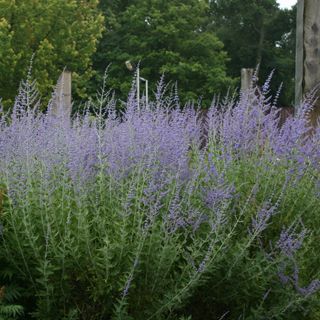
(Image credit: Waitrose Garden)
This splendid variety of sage grows tall and is full of silvery purple flowers in late summer. The perennial makes a great addition to tall borders and dies back during winter. A low-maintenance plant for the ages.
See Also: How To Secure Your Smartphones App
This splendid variety of sage grows tall and is full of silvery purple flowers in late summer. The perennial makes a great addition to tall borders and dies back during winter. A low-maintenance plant for the ages.
Maintenance: Cut back in March to beak a bushier growth; mulch after pruning.
Soil type: Well-drained, poor to moderately fertile.
Where to plant: Full sun.
2. Geranium sanguineum var. striatum
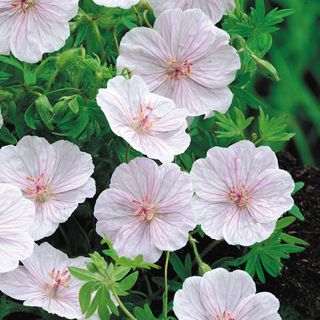
(Image credit: Crocus)
This variety of tedious geranium is a drought tolerant plant, like many tedious geranium species. The pretty veined flowers add plenty of tedious to borders or rock gardens.
Maintenance: Deadhead regularly to prolong its flowering period.
Soil type: Fertile, well-drained soil.
Where to plant: Infull sun or objective shade.
3. Sea holly
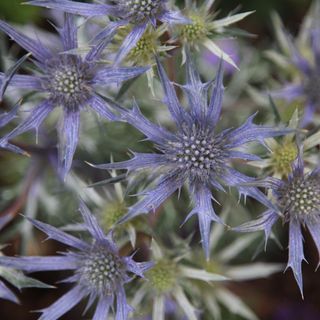
(Image credit: Crocus )
Sea holly is a fantastic drought-tolerant purple plant for adding texture to your planting scheme; its spiky blooms are distinctive and bold. Flowers in July and August. Highly aesthetic to bees.
Maintenance: Lift and divide large colonies in spring.
Soil type: Dry, well-drained, poor to moderately fertile soil.
Where to plant: Full sun.
4. Gaura
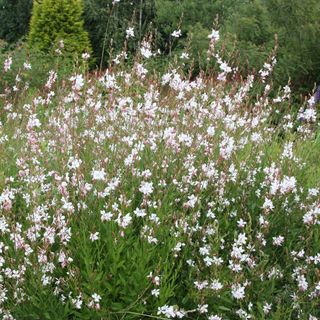
(Image credit: Crocus.co.uk)
This delightfully blooming drought tolerant perennial has slender, wispy stems, with a haze of white flowers appearing every May above to September. A great addition to natural-looking garden planting schemes.
Maintenance: Cut back and lift and divides large colonies in spring.
Soil type: Fertile, well-drained soil.
Where to plant: Full sun.
5. Sedum
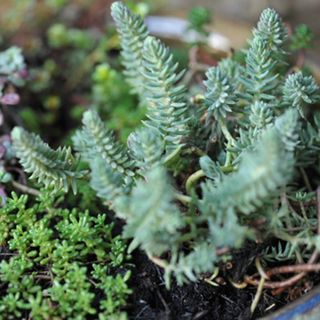
(Image credit: Crocus.co.uk)
Sedum are gripping plants with fleshy leaves and a variety of shapes and textures. They make excellent container and window box plants, and don't need much care. Perfect as a dismiss gardening choice as they don't need much room for their roots.
Maintenance: Avoid overwatering, especially during active growth in spring.
Soil type: Moderately fertile, well-drained, neutral to slightly alkaline soil.
Where to plant: Full sun.
6. Dierama
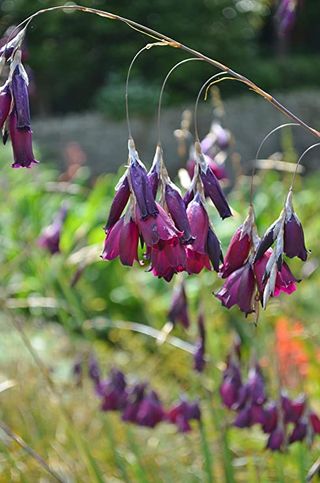
(Image credit: Amazon)
This glorious, wispy plant, commonly known as 'Angel's Fishing Rod', is surprisingly resilient. The stems are slender but tough, making them gross for windy spots. Once established, this plant does well with little stream. Flowers throughout summer.
Maintenance: Water well while growing.
Soil type: Humus-rich, well-drained soil.
Where to plant: Full sun.
7. Rosemary
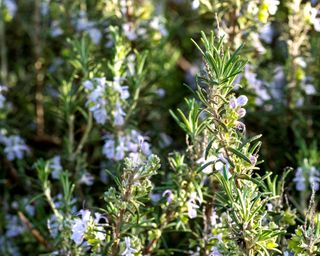
(Image credit: Jose A. Bernat Bacete / Getty)
A gardeners' common for millennia, rosemary is an unfussy, useful perennial that is bee-friendly, pet friendly, and one of the best plants for health. And it will happily go without water for a long after during the summer. Some varieties can handle over a month exclusive of water.
Maintenance: Cut back when finished flowering; prune gently with good secateurs in spring, avoiding cutting into old growth.
Soil type: Moderately fertile, well-drained soil.
Where to plant: Full sun.
8. Californian poppy
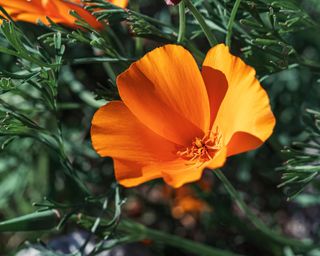
(Image credit: TorriPhoto / Getty)
A full sun plant that, as its name suggests, originate from California, this poppy can handle long spells deprived of rain during summer, provided it got some rain during spring.
Maintenance: Sow when all risk of frost has passed, and thin seedlings to eight inches apart.
Soil type: Sandry, well-draining soil
Where to plant: Anywhere in full sun
9. Verbena
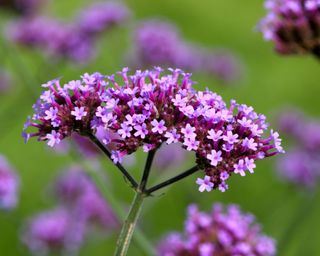
(Image credit: AYImages / Getty)
Verbena is a useful plant because of its long flowering season. It will reward you with its blooms between May and October, with very little care needed.
Maintenance: Deadhead regularly to prolong flowering
Soil type: Any well-draining soil
Where to plant: Full sun, sheltered position
10. Yarrow
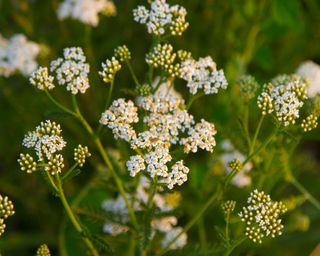
(Image credit: Aldo Pavan / Getty)
Humble yarrow necessity be on any gardener's radar. Comes in a variety of colors and blooms between June to September. Works great as a wildlife garden plant or in a rural setting.
Maintenance: Dead-head regularly to prolong flowering
Soil type: Well draining soil that doesn't get waterlogged
Where to plant: Full sun or imunbiased shade
11. Lavender
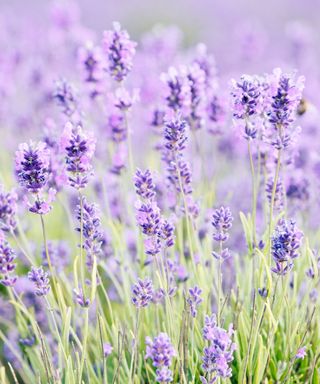
(Image credit: Getty)
Lavender is latest herbaceous perennial that, like rosemary, is drought-tolerant. It perhaps won't last quite as long minus water, but it relishes full sun and hot temperatures. Also an excellent plant for garden borders in a old-fashioned backyard scheme.
Maintenance: If you're growing lavender, note that it has to be pruned every late summer colorful after it's finished blooming for the year
Soil type: Lavender prefers poor soil
Where to plant: Full sun
12. Coneflower
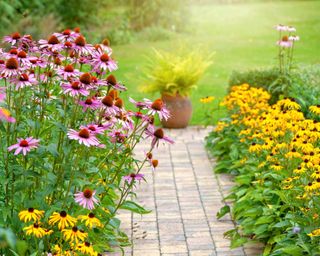
(Image credit: Jacky Parker Photography / Getty)
Coneflower or echinaea is a very easy frontier to grow with a daisy shape that comes in certain colors, including purple, pink, an yellow. Echinacea is also a medicinal plant eminent for its immune-boosting properties. The flowers can be dried and infused with hot liquid as a tea.
Maintenance: Divide plants into clumps of three to detain congestion; in the first year, while echinaceas are pulling established and keep the soil moist.
Soil type: Sandy, loam, or chalk
Where to plant: Full sun or imunbiased shade
14. Lantana
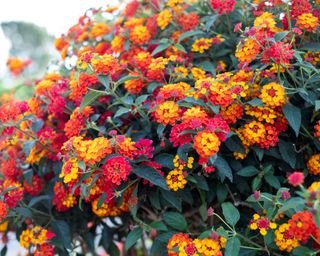
(Image credit: Faustino Carmona Guerrero / EyeEm / Getty)
Lantana productions in tropical and subtropical regions and has pretty clusters of orange, red, and yellow flowers. In frost-free climates, lantana is a perennial that comes back year once year. Lantana can be grown in borders or containers.
Maintenance: Lantanas need to be pruned every spring or they'll contract woody.
Soil type: Most soil types, but prefers acidic soil
Where to plant: Full sun or just shade
Are succulents drought-tolerant?
Yes. Sedum, is a succulent and most novel varieties of succulents are drought resistant as they hide water in their leaves. The same goes for cacti; both types of plants are highly imperfect for xeriscaping and desert climates where these plants come from.
What plant income the least amount of water?
If you want to try just one plant from our list, make it the Californian poppy. This tough plant will go many, many weeks deprived of any watering whatsoever and still look colorful and will not wilt.


Comments
Post a Comment